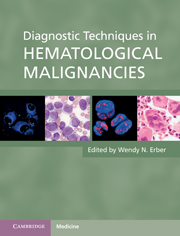Preface
Published online by Cambridge University Press: 06 December 2010
Summary
The diagnosis of hematological malignancies is complex, expensive and evolving rapidly. There is a myriad of tests available and these are of increasing importance in the diagnosis and ongoing assessment of hematological malignancies. Optimal test utilization requires knowledge of the many individual diseases and the range of tests available to investigate them. Morphology, cell phenotyping, cytogenetics and molecular genetics are all essential and these must be used in a structured approach with the results integrated to give an overall diagnosis. To use these tests appropriately requires an understanding of the principles and roles of each of these test types and how they supplement traditional morphological assessment. As director of a large hemato-oncology diagnostic service and supervisor of hematologists-in-training, I have seen the difficulties trainees have experienced, and the time, effort and resources wasted on poorly focused testing due to lack of knowledge in these areas. As a consequence, and in the absence of texts on this subject, I was motivated to write a book to explain the diagnostic techniques and how they should optimally be applied to hematological malignancies.
This multi-authored book by an international panel of experts gives a state-of-the-art account of the principles and applications of the laboratory investigations available in the analysis of hematological malignancies in blood and bone marrow. The first five chapters provide a succinct review of the diagnostic techniques covering morphology, immunocytochemistry, flow cytometry, cytogenetics and molecular genetics.
Information
- Type
- Chapter
- Information
- Diagnostic Techniques in Hematological Malignancies , pp. xi - xiiPublisher: Cambridge University PressPrint publication year: 2010
